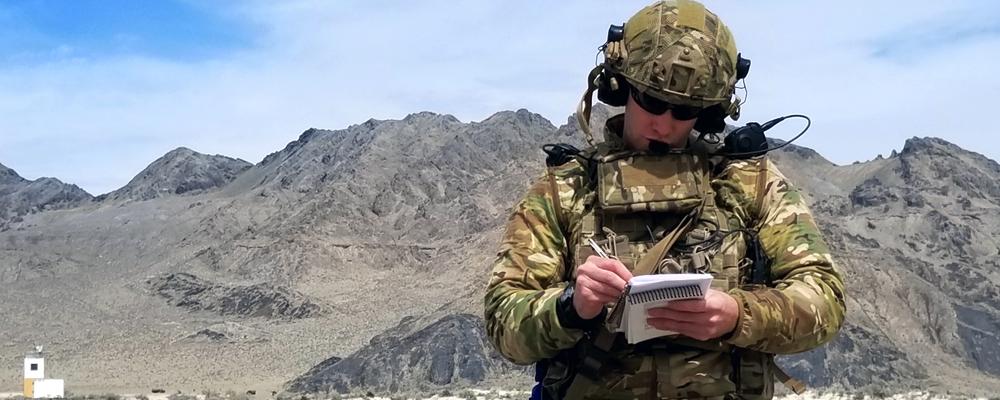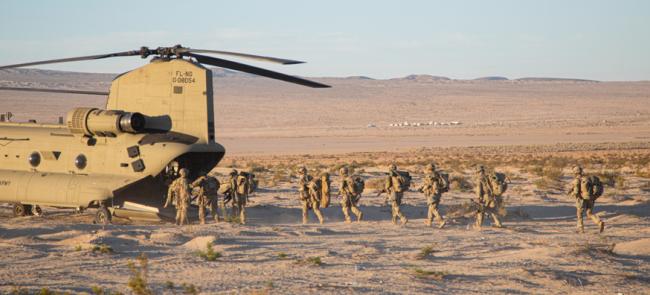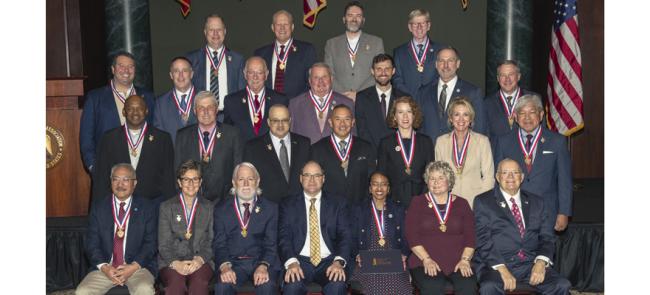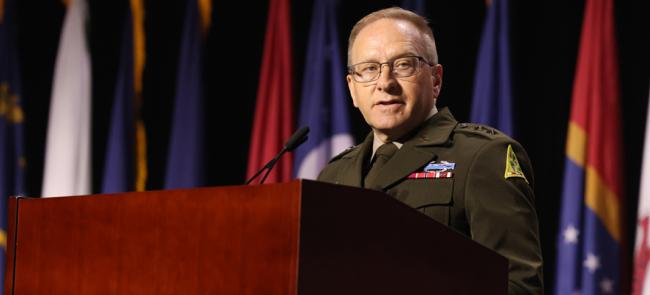
Air Guard Grunts
Sometimes the most important boots on the ground are filled by an Air National Guard E-4.
It has happened countless times in Afghanistan, Iraq and Syria over the past two decades. A senior airman, a radio his vital tool, tells an A-10 fighter pilot or a B-1 bomber crew exactly where to drop ordnance to tip the scales to U.S. and coalition troops fighting insurgents.
The airmen are part of a small, elite community of airmen known as Joint Terminal Attack Controllers —JTACs for short — who go forward with ground troops as Tactical Air Control Party, or TACP, members. Their principle job is to advise commanders on close-air support and call in airstrikes when needed.
Master Sgt. Cody Canfield, who’s been a TACP with the Illinois Air Guard’s 169th Air Support Operations Squadron for more than 10 years, can still remember the first time he directed real-time airpower. He says his heart was in his mouth. Then his extensive training took over.
“I had dropped live ordnance in training. But doing it by myself for the first time was one of the coolest and scariest things I’ve done at the same time,” he recalls. “I told myself, It’s going to explode and kill people. It’s got to be in the right spot.
“You hold your breath for the 15 or 30 seconds it’s coming down,” he says. “Then once it splashes it’s just such a sigh of relief. There is literally no one on the battlefield who holds more firepower than a TACP.”
Canfield has since exercised that power 20 or so times. He has also earned his spurs as a TACP leader. He was the noncommissioned officer in charge of a dozen JTACs, pronounced J-tacks, supporting elements of the Army’s 5th Special Forces Group against ISIS insurgents in Syria in 2019.
The awesome power JTACs and TACPs control on the battlefield is why Brig. Gen. Mark Auer, the New Mexico Air Guard chief of staff, calls Tactical Air Control Party, “a silly name for a very serious business."
Auer is considered a founding father of TACP — pronounced tack-P — as it now exists in the Guard. He was the first to command the 182nd Air Support Operations Group after it was organized in Peoria, Illinois, in 2008. The Air Guard’s other operations group, the 194th ASOG, was formed near Tacoma, Washington, in 2006.
TACPs are special warfare personnel. They jump out of airplanes and operate in the most austere conditions. They also constitute the Air Force’s first human weapons system, a distinction traditionally affiliated with aircraft, says Lt. Col. Scott Grotbo, the 182nd Group’s commander.
“I like to call us a walking sensor suite,” he says. “We have some of the most advanced radio equipment and laser targeting equipment and night-vision equipment on one individual. JTACs also carry weapons and are familiar with crew-served weapons.”
Still, most people in the Air Force and Guard know little aboutTACPs and JTACs. Even those who do, often get them confused. For the record, TACP is a career field that includes JTACs, who hold an additional certification that qualifies them to direct combat aircraft.
“If you didn’t have any life experience with close-air support, you could spend your whole career in the Air Force and not know what TACP stood for,” says Auer, who worked with them while flying F-16 fighters before venturing into the world of air-liaison officers and TACP leadership.
The responsibilities shouldered by 20-something airmen defy the imagination. These E-4s and E-5s need to be aware of all friendly forces, enemy elements and noncombatants on the battlefield. They also need to know what warplanes are available at a moment’s notice and the ordnance they pack. They also sometimes have to wave off pilots, often to the displeasure of far more senior Army commanders.
“In no other career field does a senior airman’s tactical decision today have such a profound ability to influence strategic issues tomorrow,” insists Auer.
They also draw enemy fire. Their radio antennas that are difficult to conceal make them appealing targets for enemy forces who know the destructive power a JTAC can summon.
“We definitely stand out. It’s a little terrifying,” Canfield says. The enemy knows that if they kill a JTAC, “there’s a lot less chance of those bombs dropping on their heads. You’ve just got to be fast enough so it isn’t a problem.”
Partner forces also understand and often provide JTACs with extra security. That was Grotbo’s experience with his Afghani counterparts when he was an enlisted man. “They knew they had to keep me alive,” he says. “They always understood that I was the key to airpower.”
There is literally no one on the battlefield who holds more firepower than a TACP.
—Master Sgt. Cody Canfield of the Illinois Air National Guard's 169th Air Support Operations Squadron
SO WHY DO WE KNOW SO LITTLE about TACPs and the JTACs? The reasons are varied and a bit convoluted.
The career field is small. At full strength, the Guard’s TACP force totals only about 1,330 people — 223 officers and 840 enlisted personnel, says Lt. Col. Dan Curtin, the TACP branch chief at the National Guard Bureau. Still, they make up about 42% of the Air Force’s total TACP force.
The Guard’s current footprint is even smaller as TACP currently numbers about 750 officers and enlisted personnel, about 70% strength, he says. The force is also spread out. Sixteen air support operations squadrons are located across 14 states — half east of the Mississippi River under the 182nd ASOG and the other half to the west under the 194th ASOG.
Each group oversees eight air support operations squadrons manned by JTACs. Each group also includes an air support operations center that focuses on command and control. The 194th includes a training flight in Oklahoma.
The TACP force is aligned with eight Army divisions and various brigades for training and deployments. So they frequently co-exist with, but are not commanded by, Army elements. The 169th Squadron in Illinois works with the Army Guard’s 32nd Infantry Brigade Combat Team in Wisconsin and the 33rd IBCT in Illinois.
“I tell everybody that TACP is probably more Army than it is Air Force,” says Capt. Paul Hauter, the 169th Squadron’s director of operations.
Generally speaking, when the Army units train or go to war, Air Guard TACPs go with them. And the soldiers certainly know who they are.
“They are the most professional airmen, I would say, as well as down-to-earth people,” said Sgt. 1st Class James Brown, who began working with TACPs as a 32nd Brigade joint fires observer in 2017. “Their rank really doesn’t matter. They look to utilize you and teach you based on your knowledge and skill sets.”
TACP does not have a separate, distinct higher command. It is part of the Air Force’s Air Combat Command. The two groups are the highest echelon in the Guard. The groups and the squadrons predominantly fall under flying wings with which they may have very little in common.
The 182nd ASOG and its two squadrons, for example, are part of the 182nd Airlift Wing at Peoria Air National Guard Base.
“We’re lucky we have two groups,” says Lt. Col. David Stilli, the new commander of the 194th ASOG, which is part of the 194th Wing in Washington state. “But what I think would help even more would be to establish an Air Guard special warfare wing.”
It would go a long way toward institutionalizing Air Guard special warfare into the Air Force corporate process, he says.
Close-air support on foreign battlefields may be the primary mission, but Guard’s TACPs also employ their communication expertise and equipment to support domestic operations. “We help expand a lot of state emergency management agencies’ capabilities to talk to adjacent states, cities, localities,” Grotbo says.
Squadrons in Mississippi, Louisiana and Texas are well versed in hurricanes, Stilli says. Those in Kansas and Oklahoma deal with tornadoes. And Idaho and Washington units know all about the wildfires that seem to burn longer and scorch larger areas of the West Coast every summer and autumn.
TACPs have used infrared sensors to seek out hotspots invisible to the naked eye so that fire teams can get ahead of them during wildfire season and to search for people trapped in burning buildings.
TACP is probably more Army than it is Air Force.
—Capt. Paul Hauter, the director of operations of the Illinois Air National Guard's 169th Air Support Operations Squadron
AMERICAN PILOTS have long had help on the ground to assist with putting bombs on target. The Army Air Corps dispatched fliers to the front in tanks to improve the effectiveness of close-air support in Europe during World War II, according to a 2007 Air Command and Staff College report.
Since then, the Air Force’s forward-observation corps has evolved in two significant ways. Enlisted airmen have largely replaced the officers on the battlefield, and JTAC-seasoned officers are replacing pilots as TACP leaders.
Air support operations squadrons manned by enlisted personnel were originally commanded by rated pilots who spent a couple of years as air-liaison officers before returning to their cockpits. The pilots provided close-air support expertise, but the frequent changes in leadership deprived the squadrons of continuity of command, which was not a satisfactory arrangement.
The Air Force, around 2007, created a new position — nonrated, or nonflying, air-liaison officers who now become fulltime TACP officers.
Today, maintaining personnel strength is among the big challenges. The problem is, few people possess the grit, stamina, intellect and hyper drive to become a JTAC-qualified TACP. It also takes a lot of time — up to two years. The curriculum includes Army jump school and the Air Force’s combat survival school.
The attrition rate runs as high as 70% during the early going. The numbers for the 169th Squadron from 2015 to 2020, according to Hauter, the unit’s operations director, are pretty typical: 66 enlisted from 2015 to 2020, 23 passed the medical and physical tests; 15 graduated.
He and others in the TACP community believe attracting more TACPs leaving the active Air Force would be a big help. They are already fully trained. Unfortunately, there is no coordinated effort at the national level to market TACP opportunities in the Guard to those in the active component. Instead, it is every unit for itself relying on word of mouth.
The unit training is also intense. “On average, you’re looking at about 90 days a year minimum that’s needed for our force to maintain proficiency,” says Capt. John Robertson, the chief of weapons and tactics for the Peoria group. “We have the exact same requirements as active duty when it comes to currency and proficiency, but the Guard has to fit its training into a very small training calendar.”
Extra pay can be an incentive. Enlisted people in all services “with duties that are extremely difficult” are eligible for up to another $600 per month, although the variable rates are lower than that, states the Defense Department’s compensation website.
But all of that training, and the extra income, does not necessarily lead to longevity. At 31, and after 11 years in the Guard, Canfield from Illinois is among the oldest JTACs. “It is a young man’s game,” he says.
The satisfaction of being a TACP can be offset by the challenges of performing well in civilian jobs, raising families, the physical demands and extra training required to remain ready, and the stress of deployments that can last from six months to a year.
“We try to manage that in the Guard, but it is challenging to keep these guys retained,” Canfield adds. “I would say six years is pretty standard. You don’t see many [stay] after six to 12.”
THE AIR GUARD’S SMALL TACP FORCE has had its casualties and heroes.
Illinois Staff Sgt. Jacob Frazier gained immortality when he was killed in Afghanistan on March 29, 2003, early into the war against terrorism. Frazier’s team was ambushed as it was trying to assist another team, including Scott Grotbo and Dan Curtin, which had made enemy contact, Grotbo recalls.
Retired Washington Chief Master Sgt. Kevin Whalen possesses a Silver Star and a Purple Heart for heroism in Afghanistan on July 19, 2003.
More recently, Illinois 2nd Lt. Matthew Denault received the Joint Service Commendation Medal for Valor after distinguishing himself in Afghanistan from January 17 to February 12, 2020.
His citation is typical of those that describe JTACs’ ordeals under fire. Denault “braved enemy fire which struck the teammate next to him in order to coordinate with the ground commander and identify targets exposed from [a] rooftop. Subsequently, he directed a medical evacuation, artillery and controlled multiple strafe passes while using attack helicopters and A-10s, including a ‘danger close' engagement which ultimately led to the safety of the patrol and decimated the enemy assault.”
Sometimes, regrettably, munitions hit something other than their intended target. It’s called collateral damage or fratricide or “friendly fire” — when civilians or friendly soldiers are hit by the fire that JTACs initiate.
“Our job is not to let that happen,” Canfield says.
But occasionally it does. Simulators, on which TACPs frequently train, can be programmed for these worst-case scenarios, explains Grotbo, the 182nd Group’s commander.
“You have to help them realize that they have to keep going. They can’t freeze,” should it happen in real life. “You have to train your brain. You have to finish the mission. There will be time to assess and deal with some of that collateral damage after the threat is neutralized.”
Furthermore, he says, “Now we finally have a lot of people and places to help these airmen, whether it’s licensed counselors or retreats where we can send folks so we’re not just inflicting personnel with these traumatic events and then they’re left to their own demise after that.”
Some believe the Guard could do even more by funding a human performance and optimization program. HPO provides for facilities and professionals such as physical therapists and exercise coaches to prepare airmen for deployments and counselors to help them cope with the aftermaths of combat when they return.
“The active-duty Air Force has a great program at Lackland [Air Force Base, Texas],” says Stilli, the commander of the 194th ASOG.
“We don’t have the funding for that in the Air Guard right now. That’s where I think we’re woefully inadequate. When TACP was designated a human weapons system a few years ago, that came with a lot of expectations. Part of that was to take care of the weapons system.
“You need to put money towards that — taking care of our airmen.”
Bob Haskell is a retired Maine Army National Guard master sergeant and a freelance journalist in Falmouth, Mass. He may be contacted via [email protected].
Air Support Operations Squadrons
Georgia
165th ASOS
Savannah Air National Guard Base
Idaho
124th ASOS
Gowen Field Air National Guard Base (Boise)
Illinois
168th ASOS & 169th ASOS
Peoria Air National Guard Base
Indiana
113th ASOS
Terre Haute Air National Guard Base
Kansas
284th ASOS
Salina Air National Guard Detachment
Louisiana
122nd ASOS
New Orleans Lakefront Airport
Mississippi
238th ASOS
Key Field Air National Guard Base (Meridian)
New Jersey
227th ASOS
Atlantic City Air National Guard Base
New York
274th ASOS
Hancock Field Air National Guard Base
North Carolina
118th ASOS
New London Air National Guard Base
Oklahoma
146th ASOS
Will Rogers Air National Guard Base (Oklahoma City)
Pennsylvania
148th ASOS
Air Station Fort Indiantown Gap
Texas
147th ASOS
Ellington Field Joint Reserve Base (Houston)
Washington
111th ASOS & 116th ASOS
Camp Murray Air National Guard Station (Tacoma)
Source: Air Force



